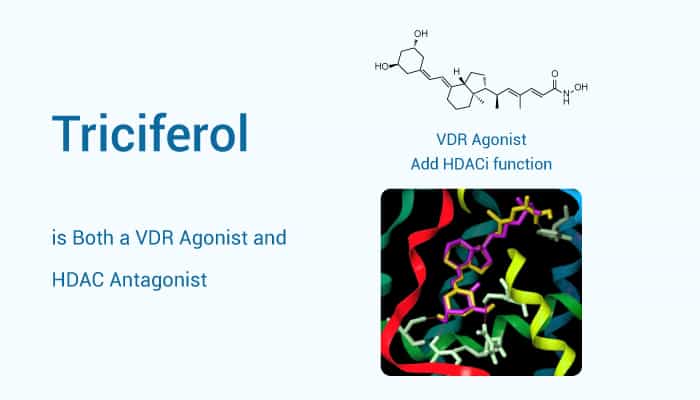The biologically active metabolite of vitamin D3, 1α,25-dihydroxyvitamin D3 (1,25D), is a primary regulator of calcium homeostasis. 1,25D also controls cell differentiation and proliferation through binding to the nuclear vitamin D receptor (VDR). It regulates histone acetylation, chromatin remodeling, and recruitment of RNA polymerase II and ancillary factors required for target gene transcription. 1,25D analogs have therapeutic potential in the treatment of hyperproliferative disorders, such as cancer and psoriasis. Moreover, 1,25D is also a direct inducer of antimicrobial innate immunity. The finding has provided a molecular genetic basis for its activity against Mycobacterium tuberculosis infections. Histone deacetylase inhibitors (HDACis) alter nuclear and cytoplasmic protein acetylation and modify gene expression. They have the potential for the treatment of cancer and other indications. The function of nuclear receptor ligands, including 1,25D, can be enhanced in combination with HDACi. In this study, Triciferol has VDR agonist and HDAC antagonist activities.

Triciferol is a multiple ligand agent that combines VDR agonism and HDAC inhibition to enhance the cytostatic and cytotoxic activities of 1,25D.
The compound functions as a multiple ligands with combined VDR agonist and HDAC antagonist activities. It binds directly to the VDR (IC50=87 nM), and functions as an agonist with 1,25D-like potency on several 1,25D target genes. It also induces marked tubulin hyperacetylation and augments histone acetylation. Antiproliferative and cytotoxic activities. Triciferol is significantly more efficacious in suppressing the proliferation of estrogen receptor-negative human MDA-MB231 breast cancer cells. Treatment of MCF-7 cells with Triciferol (100-1000 nM) induces ≈2.5-fold higher rates of cell death than equimolar amounts of 1,25D.
In summary, Triciferol binds directly to the VDR, and functions as an agonist with 1,25D-like potency on several 1,25D target genes. Moreover, Triciferol induces marked tubulin hyperacetylation and augments histone acetylation at concentrations that largely overlap those where VDR agonism is observed. Triciferol also exhibits more efficacious antiproliferative and cytotoxic activities than 1,25D in four cancer cell models in vitro.
Reference:
Tavera-Mendoza LE, et al. Proc Natl Acad Sci U S A. 2008;105(24):8250-8255.